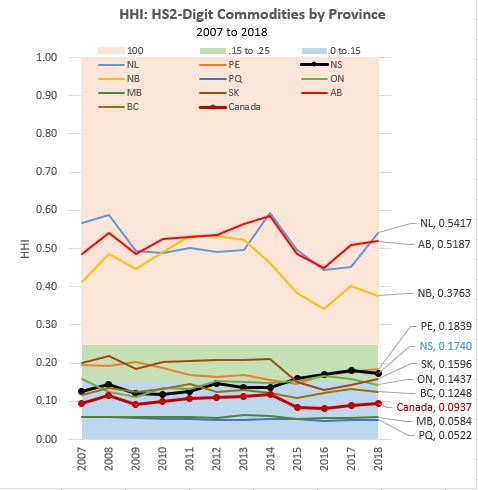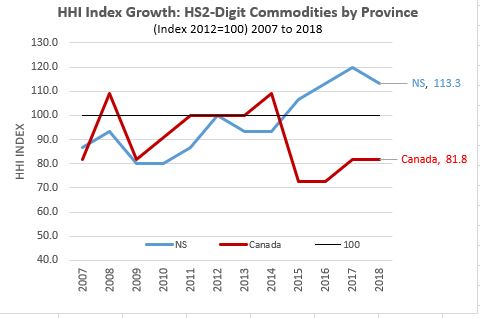The Economics and Statistics Division maintains archives of previous publications for accountability purposes, but makes no updates to keep these documents current with the latest data revisions from Statistics Canada. As a result, information in older documents may not be accurate. Please exercise caution when referring to older documents. For the latest information and historical data, please contact the individual listed to the right.
<--- Return to Archive
For additional information relating to this article, please contact:
April 03, 2019MERCHANDISE TRADE DIVERSITY BY PROVINCE 2007-2018 Introduction
Canada's provinces are widely exposed to international trade and the income generated from goods exports is a substantial part of nominal GDP. The degree to which each province's goods exports are concentrated commodities and destinations, or diversified across a range of outputs and destinations, signals its exposure to fluctuations in international markets. The normalized Herfindahl-Hirschman Index (HHI) shown below assesses trade concentration and diversity measured on a scale from 0.0, representing complete diversification, to 1.0, representing complete concentration.
While more concentration of output exposes a province to fluctuations in a market, it can also indicate specialization that allows a province to make the most advantageous terms of trade. For example, Alberta and Newfoundland and Labrador have benefitted from concentrated output in high-valued oil products from 2002 to 2014, but both felt impacts because of falling prices over the last 4 years.
Export Product Diversification
The two-digit Harmonized System (HS) of commodity classification has 97 commodity codes that are used for computing the HHI indexes for Canada and the provinces. Special transactions exports (codes 98 and 99) are not used by Statistics Canada in their HHI calculations.

A provincial HHI score between 0 and 0.1499 would categorize a province or country as diversified with respect to the international merchandise trade export market. Over the period 2007-2018, Canada trade in goods has been categorized as diverse, hovering between 0.0800 and 0.1168. British Columbia, Manitoba, and Quebec maintained a diverse status over the 2007-2018 period as well.
Nova Scotia and Ontario traded places with Nova Scotia being classified as diverse in 2007-2014 and moderately concentrated 2015-2018, and Ontario hovering on the line between diverse and moderately concentrated over the 2007-2018 period.
A provincial HHI score between 0.15 and 0.2499 would categorize a province as moderately concentrated with respect to the international merchandise trade export market. Saskatchewan was classified as moderately concentrated over most of the 2007-2018 period, dipping into the diverse category 2015-2017, only to return to moderately concentrated in 2018. Prince Edward Island was classified as moderately concentrated over most of the period, except for 2015.
A provincial HHI score between 0.25 and 1.0 would categorize a province as concentrated with respect to the international merchandise trade export market. Over the 2007-2018, Newfoundland and Labrador, New Brunswick, and Alberta were categorized as concentrated. Three provinces met the criteria in 2007, and the same three met the criteria in 2018.


Since 2012 the HHI Index of growth for Canada merchandise trade exports declined from 100.0 in 2012 to 72.7 in 2015-2016 and increasing to 81.8 in 2017-2018. In 2012 mix of merchandise exports were diverse and trending to more diverse.
In Nova Scotia, commodity diversity (HHI Index) initially became less consentrated, declining to 93.3 in 2014. Nova Scotia exports quickly became more concentrated up to 2017 with the index increasing 26.7 points to 120. The period ended with the index declining 6.7 points to 113.3.

Sources: Statistics Canada
STC Daily December 11, 2017;
Article: Measuring Canadian Export Diversification;
Authors computations with Trade Data were rounded to 4 decimal places and were reconciled with Statistics Canada data from 228-0082 which were rounded to 2 decimal places.
Statistics Canada Data
12-10-0129-01
Product concentration ratio by province
Product concentration index by province
Country concentration ratio by province
Country concentration index by province
Trade Data On-line
<--- Return to Archive